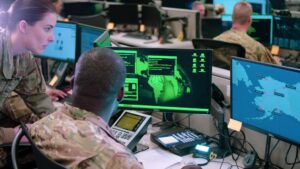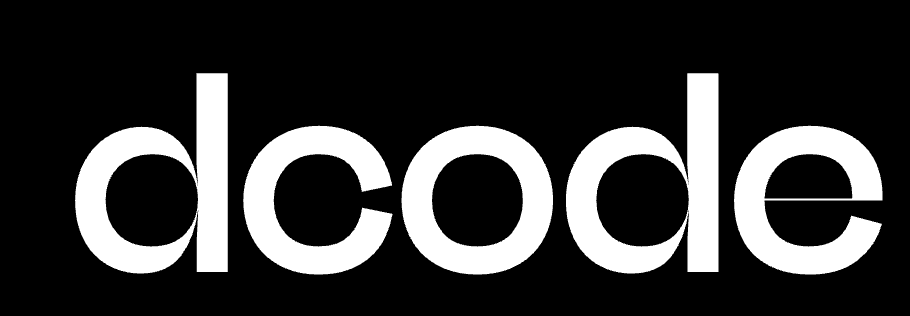As cybersecurity threats to modern warfare systems increase, managing risk across the Department of Defense (DoD) is non-negotiable, yet critical compliance measures often stall innovation and rapid response to a complex cyber landscape. Meeting this inflection point with outcomes-based technology and strategy will require rethinking DoD’s approach to managing cyber risk by modernizing and streamlining its Risk Management Framework (RMF) compliance processes – enabling defense programs to acquire and deploy commercial cutting-edge technologies and capabilities at the speed of mission relevance. In fact, DOD leadership has made clear that industry involvement in RMF modernization is a priority.
In this Insights series, we take a look at key approaches to helping DoD streamline RMF compliance and boost the efficiency of cyber risk reduction efforts. In this first part, we’re looking at the complementary efforts of deploying advanced AI and automation technologies for cyber compliance alongside robust governance practices.
Leveraging Advanced AI and Automation Tools to Boost RMF Efficiency
Advanced AI technologies that can improve RMF efficiency and automate compliance workflows for rigorous cybersecurity frameworks exist today, and implementing these tools would enable DoD to:
- Reduce labor hours for security and development teams, freeing up more resources for mission-critical tasks
- Ensure IT systems and assets meet stringent cybersecurity compliance requirements detailed by the National Institute of Standards and Technology (NIST)
- Improve the effectiveness and efficiency of cybersecurity testing, compliance checks, and reporting
- Boost the accuracy and timeliness of security findings and enforce security requirements early and continuously
- Streamline the process of achieving required authorization to operate (ATO) for new technologies, ensuring faster capability deployment and ROI
Key Uses of AI and Automation for RMF Compliance
- AI-powered scanning to automate security testing and compliance checks can efficiently scan source code for vulnerabilities and standards violations and prevent insecure or low-quality code from entering production.
- Automated identification of open-source dependencies for supply chains and infrastructure can help streamline the process of ensuring that open-source code libraries are up to date and secure – a critical task given that nearly 80% of commercial IT products are developed using open-source tools.
- AI-powered risk prioritization and reporting can efficiently reveal emerging threats in real-time alongside actionable insights into the varying risk levels of different types of threats to aid decision making. These tools can also streamline the process of generating essential documentation and security artifacts to support RMF compliance efforts.
- Automated architecture configuration compliance tools can help ensure the security of cloud environments by continuously scanning for misconfigurations or security violations, auto-generating alerts, and initiating remediation actions when needed. Complementary tools can offer a network-level view of security policy compliance across cloud, on-prem, and hybrid environments.
Centralizing Governance to Ensure RMF Impact Across IT Systems
While advanced AI and automation tools are key to DoD’s goals of reducing cyber risk and streamlining compliance, these solutions are only as effective as the supporting governance structures that enable their efficient use and impact. Robust security governance embedded throughout the system development lifecycle is crucial to supporting system security, reliability, and reciprocity of IT assets and tools across defense agencies and programs. At Dcode, we guide our defense customers in embracing a centralized governance approach:
- Repeatable DevSecOps pipelines are essential for implementation of the AI and automation tools above. They ensure tight integration of development, security, and operations workflows to prioritize system security continuously and iteratively along the development lifecycle – enabling teams to discover and address risks early on and reduce their associated time and expense.
- Standardized security testing and controls continuously demonstrate alignment with RMF and other security requirements to ensure compliance.
- Standardized deployment environments help centralize oversight – reducing redundant security efforts and enabling accelerated ATO and deployment for new systems and capabilities.
- Centralized system vulnerability reporting with automated system performance monitoring helps to meet evolving security and compliance requirements with adjustable, built-in metrics.
By coupling advanced technologies with robust governance structures, DoD can improve the efficiency and speed of RMF processes and compliance across defense programs and mitigate cyber risks in an accelerating threat environment.
In part 2 of this series, we’ll look at how defense programs can upskill to embrace rapid acquisitions with an emphasis on security issues to support RMF compliance.
Connect with us below to talk about how Dcode can help modernize and automate your software security tasks.
The appearance of U.S. Department of Defense (DoD) visual information does not imply or constitute DoD endorsement. (U.S. Air Force Photo by Maj. Christopher Vasquez)


